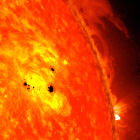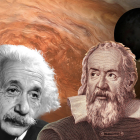It is known to Galileo as one of the first scientists to systematically measure and use a scientific method orderly and efficient. Galileo’s physics is characterized by the measurement and use of mathematical laws. However, classical atomism He did not measure or use mathematics to demonstrate assertions about the ultimate constitution of matter. Nevertheless, atomism is present in all Galilean literary work, despite the fact that Galileo himself never openly declared himself an atomist. Let’s see what the atomistic vision of the Pisan physicist is and why. turn to atomism on various occasions throughout his life.
Portrait of John Dalton (1823). Among his works, the atomic model and his table of relative weights of the elements stand out, which contributed to laying the foundations of modern chemistry.Wellcome
Galileo’s atomisms
Until the arrival of John Dalton (1766-1844)almost two centuries after Galileo’s death, we would not have precise and well-founded explanations about the real existence of atoms.
Dalton was the first to publish a table of relative atomic weights, with six elements: hydrogen, oxygen, nitrogen, carbon, sulfur and phosphorus. Dalton’s approach and conclusions were based on the analysis of chemical reactions. His excellent assumption was the defense that atoms combine in a specific way. For example, water (H₂O) It combines so that there are two hydrogen atoms for every one oxygen atom. The big difference between the classical atomism of antiquity (Democritus, Leucippus, Lucretius, etc.) is that mathematics became part of a terrain that was reserved for speculation and as a general and diffuse philosophy to explain the structure of matter.
Galileo’s atomism suffered from this problem, since He didn’t know how to combine mathematics and his ideas remained on wet paper. Like the classical atomists, his claims in this area lacked any experimental support. However, he served support some of his ideas about the floating or falling of bodiesin which he did know how to introduce mathematics.

Eugenio M. Fernández Aguilar
Galileo’s view of the corpuscular nature of matter evolves throughout his work. There are three stages that our protagonist’s atomistic vision underwent: a mechanistic atomism of atoms with extension and indivisibles (1611-1615), passing through a mixed atomism with extended particles but with light formed by atoms without extension (1615-1623) to end with a mathematical atomism of atoms without extension applied to physics (1626-1642). Let’s study a little more closely these three moments in Galileo’s work.
Portrait of Galileo Galilei by Justus Sustermans (1636)Wikimedia
Extended and indivisible atoms, Galileo’s mechanistic atomism
Galileo’s first formal reference to the term atom is from 1611 and appears in his work Discorso intorno alle cose che stano in su l’acqua o che in quella si muovono (Discourse about things that are in water or that move in it):
“Therefore, the objection of Aristotle against Democritus by stating that ascending igneous atoms support grave bodies […]».
Democritus’s position regarding “igneous atoms” (atomi ignei) either atoms of fires It is the defense that these in the water rose dragging the sunken bodies, so they would float. Aristotle tried to refute this claim based on the shape of objects. In Galileo’s mind, the atomi ignei They exist, but they do not have the capacity to support heavy bodies.
Nor did he support the Aristotelian view of sinking based on the shape of the object. Galileo was a fervent follower of Archimedes, so it explains buoyancy based on Archimedean principles. That is, Galileo saw that the reason for the floating was the specific gravity (density) of the body with respect to the fluid. The variation in specific weight would be due to condensation or rarefaction, as it would be responsible for modifying its volume.
This is the starting point of the first stage in Galileo’s atomism: he will base his physics on an atomic structure of matter composed of indivisible corpuscles with extension. Even though in Discorso intorno alle cose che stano in su l’acqua o che in quella si muovono does not mention the indivisibility or extension of the atom, yes it refers to the term atomso it is very likely that he was referring to the classical concept of the atom.
In this first stage (1611-1615) he is subject to the classical atomism, as it refers to tiny indivisible, although extensive, particles separated by extensive empty spaces. Here there is no correspondence between the physical and mathematical components. In Yostory and demonstrations inside all the macchie solari (History and demonstrations of sunspots)—letter sent in 1612—addresses and defends the idea that light is not a specific substance, noting that light is composed of subtle and fast corpuscles. This approach will lead to the closure of its first atomistic stage to fully enter the second.
Interior pages of Istoria e dimostrazioni intorno alle macchie solari (1622).ASC
The corpuscular nature of light
The work Il Saggiatore (The tester), from 1623, constitutes the central nucleus of Galileo’s second atomistic stage (1615-1623). In this book he points out—not without reason—that condensation and rarefaction is one of the biggest problems in physics. The study of the states of aggregation of matter and the heat related to them will be one of the points that takes Galileo towards a mixed atomistic visionlink between the first and third stages.
Your perception of light will come above all from your astronomical observations, both with bodies that radiate light (Sun) and with those that reflect it (Moon, Venus and other planets). Is the observation of light and heat phenomena the one that shakes classical atomism in the Galilean world.

As defended in Il Saggiatorethe minima of fire at high speed penetrate the substances until they divide them. Light would be composed of indivisible and inextended atoms, of maximum rarefaction, since they occupy everything, and of instantaneous diffusion. Fire, on the other hand, is minimal, penetrating and fast particles—not instantaneous—but extensive, with shape. That is, in order to analyze his observations about the Sun and fire, added to the extensive indivisible atoms from its first stage some inextended corpuscles that would form the light.
Cover of the work Discorsi e dimostrazioni matematiche, intorno a due nuove scienze (1638).Galileo Museum
Mathematical atomism, the final conclusion of Galileo Galilei
This period, from 1626 to 1642, would cover the last stage of his life, while the house arrest lasted. The properties of light that were announced in Il Saggiatore They are now extendable to all matter. The central core of the atomistic vision of this stage is found in Discorsi e dismostrazioni matematiche, intorno due new science (Discourse and mathematical demonstration, around two new sciences), published in 1638. The title is often translated as Dialogue about two new sciences.
And what are these sciences? The resistance of materialson the one hand, and the dynamicsfor another.
While atomism in the first stage was necessary to address the floating problem and in the second to attack the cosmological problems related to light, in this last phase there is no direct technical motivation. Nor does it need to be done for the study of the resistance of the materials nor for the study of movement of bodieswhich will only be enough using mathematics of the continuum for space, time and speed, without having to extend it to the moving bodies themselves.
The vision of continuous time may clash with the image of a seconds hand that advances in jumps, but it will be enough to imagine a clock with enough gears to make it appear that the hand moves constantly and continuously. This instrumentalist mathematical continuity For physical magnitudes Galileo extends it to matter itself.
Therefore embrace a mathematical atomism in which the matter is constituted by atoms without extension and, therefore, indivisible. Just as there are infinite points on a line, Galileo defended in this last stage infinite atoms in matter. The difference between the states of aggregation must have been the voids scattered between the atoms, which gave cohesion to the solid.
Representation of the model of atom and elementary particlesShutterstock
Background to 20th century mechanics
The passage from extended minima to inextended atoms already appears in the First Day of the Discorsi. The issue comes up when analyzing the cause of the cohesion and resistance of bodies to tensile rupture. It would be due to two factors: the resistance to the formation of a vacuum and a force that unites them, a kind of “tail.” Although in Galileo there are still certain reminiscences of the Aristotelian horror vacui, presents an example that shows the existence of emptiness In some situations. If two marble slabs are perfectly polished, they will stick together because air cannot get between them to separate them. The approach to the situation is unconvincing and straddling “vacuum resistance” to “vacuum suction”.
In a parallel between the macroscopic and microscopic world he states: «There is no doubt that this same resistancewhich we so sensitively perceive between the two plates, must also exist Similarly, and at least as a concomitant cause of coherence, between the parts of the solids».
Much of this first day shows astonishing paradoxes without relevant results for physics. What’s more, Salviati, one of the characters, shows little hope when answering on one occasion “we are between the infinite and the indivisible, those incomprehensible to our intellect due to their greatness and these due to their smallness. And later, “it is in itself incomprehensible to us.”

Pablo Rodríguez Sánchez
The truth is that unifying the new mathematical approach to motion with a theory of matter is a brilliant idea, but Galileo did not do wellbasically because failed to mathematize the study of atoms nor have a very accurate vision. However, Galileo continues to shine, like the light that he analyzed and that had so many reflections in his head. In the DiscorsiFor example, talks about the finite nature of the speed of lighta complete antecedent to the mechanics of the 20th century in the mouth of Salviati:
«I have certainly not carried out the experiment, except at small distances, that is, less than a mile, and I have not been able to be sure whether the appearance of the opposite light is instantaneous; but If it’s not instantaneous, at least it’s very fast. and I would even say momentary, and for now I would compare it with the movement that we see produced in the glare of lightning, seen between the clouds eight or ten miles away.






